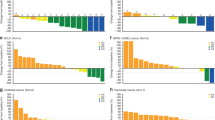Abstract
Our aim was to evaluate the effectiveness of adalimumab (ADA) during a 24-month study period in patients affected with Behçet’s disease (BD). Clinical and therapeutic data from 100 consecutive BD patients treated with ADA were retrospectively collected and statistically analyzed. At 12-week follow-up, ADA induced clinical efficacy in 81 patients, with a mean time to response of 7.63 ± 3.43 weeks; 25 (30.9 %) patients underwent a disease relapse after 22.17 ± 1.57 months, but treatment adjustments allowed a recovery of efficacy in 11 cases. At 24-month follow-up, 67/100 patients were still on ADA therapy despite concomitant treatments. No differences were identified between ADA monotherapy and co-treatment with DMARDs about efficacy (p = 0.09), time to response (p = 0.61), relapses (p = 0.36), and ADA discontinuation (p = 0.40). No differences existed in patients switched from other tumor necrosis factor (TNF)-α inhibitors about efficacy at 12 weeks (p = 0.13) and rapidity of response (p = 0.93) while relapses (p = 0.01) and ADA discontinuation at 24 months (p = 0.001) were significantly more common. Adverse events occurred in 10 patients. ADA confirmed its effectiveness in BD. Combination therapy with DMARDs seems not significantly superior to monotherapy. Frequency and time to response for ADA was not conditioned by a previous lack or loss of efficacy to other TNF-α inhibitors, but long-term loss of efficacy seemed more likely in patients switched from other anti-TNF agents.
Similar content being viewed by others
References
Alpsoy E (2016) Behçet’s disease: a comprehensive review with a focus on epidemiology, etiology and clinical features, and management of mucocutaneous lesions. J Dermatol 43:620–632. doi:10.1111/1346-8138.13381
Rotondo C, Lopalco G, Iannone F et al (2015) Mucocutaneous involvement in Behçet’s disease: how systemic treatment has changed in the last decades and future perspectives. Mediat Inflamm 2015:451675. doi:10.1155/2015/451675
Hatemi G, Seyahi E, Fresko I, Talarico R, Hamuryudan V (2015) Behçet’s syndrome: a critical digest of the 2014–2015 literature. Clin Exp Rheumatol 33:S3–14
Saadoun D, Wechsler B, Desseaux K et al (2010) Mortality in Behçet’s disease. Arthritis Rheum 62:2806–2812. doi:10.1002/art.27568
Vitale A, Rigante D, Lopalco G et al (2016) Interleukin-1 inhibition in Behçet’s disease. Isr Med Assoc J 18:171–176
Rigante D (2010) The protean visage of systemic autoinflammatory syndromes: a challenge for inter-professional collaboration. Eur Rev Med Pharmacol Sci 14:1–18
Caso F, Costa L, Rigante D et al (2014) Biological treatments in Behçet’s disease: beyond anti-TNF therapy. Mediat Inflamm 2014:107421. doi:10.1155/2014/107421
Vitale A, Rigante D, Lopalco G et al (2016) New therapeutic solutions for Behçet’s syndrome. Expert Opin Investig Drugs 25:827–840. doi:10.1080/13543784
Hatemi G, Silman A, Bang D et al (2008) EULAR recommendations for the management of Behçet disease. Ann Rheum Dis 67:1656–1662. doi:10.1136/ard.2007.080432
Vallet H, Riviere S, Sanna A et al (2015) Efficacy of anti-TNF alpha in severe and/or refractory Behçet’s disease: multicenter study of 124 patients. J Autoimmun 62:67–74. doi:10.1016/j.jaut.2015.06.005
Tanida S, Inoue N, Kobayashi K et al (2015) Adalimumab for the treatment of Japanese patients with intestinal Behçet’s disease. Clin Gastroenterol Hepatol 13:940–8.e3. doi:10.1016/j.cgh.2014.08.042
Interlandi E, Leccese P, Olivieri I, Latanza L (2014) Adalimumab for treatment of severe Behçet’s uveitis: a retrospective long-term follow-up study. Clin Exp Rheumatol 32:S58–S62
Calvo-Río V, Blanco R, Beltrán E et al (2014) Anti-TNF-α therapy in patients with refractory uveitis due to Behçet’s disease: a 1-year follow-up study of 124 patients. Rheumatology (Oxford) 53:2223–2231. doi:10.1093/rheumatology/keu266
Aamar S, Peleg H, Leibowitz D, Chajek-Shaul T, Hiller N, Heyman SN (2014) Efficacy of adalimumab therapy for life-threatening pulmonary vasculitis in Behçet’s disease. Rheumatol Int 34:857–860. doi:10.1007/s00296-013-2693-4
Criteria for diagnosis of Behçet’s disease (1990) International study group for Behçet’s disease. Lancet 335:1078–1080
International Team for the Revision of the International Criteria for Behçet’s Disease (ITR-ICBD) (2014) The international criteria for Behçet’s disease (ICBD): a collaborative study of 27 countries on the sensitivity and specificity of the new criteria. J Eur Acad Dermatol Venereol 28:338–347. doi:10.1111/jdv.12107
Neves FS, Moraes JC, Kowalski SC, Goldenstein-Schainberg C, Lage LV, Gonçalves CR (2007) Cross-cultural adaptation of the Behçet’s disease current activity form (BDCAF) to Brazilian Portuguese language. Clin Rheumatol 26:1263–1267
Olivieri I, Leccese P, D’Angelo S et al (2011) Efficacy of adalimumab in patients with Behçet’s disease unsuccessfully treated with infliximab. Clin Exp Rheumatol 29:S54–S57
Perra D, Alba MA, Callejas JL et al (2012) Adalimumab for the treatment of Behçet’s disease: experience in 19 patients. Rheumatology (Oxford) 51:1825–1831
Cantarini L, Talarico R, Generali E (2015) Safety profile of biologic agents for Behçet’s disease in a multicenter observational cohort study. Int J Rheum Dis. doi:10.1111/1756-185X.12732
Cantarini L, Lopalco G, Caso F et al (2015) Effectiveness and tuberculosis-related safety profile of interleukin-1 blocking agents in the management of Behçet’s disease. Autoimmun Rev 14:1–9. doi:10.1016/j.autrev.2014.08.008
Author information
Authors and Affiliations
Corresponding author
Ethics declarations
Disclosures
None.
Additional information
Donato Rigante and Luca Cantarini equally contributed to this manuscript.
Rights and permissions
About this article
Cite this article
Vitale, A., Emmi, G., Lopalco, G. et al. Adalimumab effectiveness in Behçet’s disease: short and long-term data from a multicenter retrospective observational study. Clin Rheumatol 36, 451–455 (2017). https://doi.org/10.1007/s10067-016-3417-4
Received:
Accepted:
Published:
Issue Date:
DOI: https://doi.org/10.1007/s10067-016-3417-4




